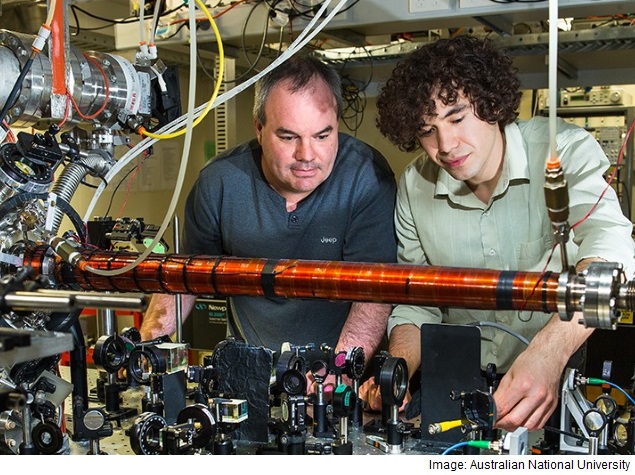- Home
- Science
- Science News
- Quantum Experiment Confirms Reality Doesn't Exist Until Measured
Quantum Experiment Confirms Reality Doesn't Exist Until Measured

Physicists at The Australian National University (ANU) have conducted John Wheeler's delayed-choice thought experiment, which involves a moving object that is given the choice to act like a particle or a wave.
Wheeler's experiment then asks - at which point does the object decide?
Common sense says the object is either wave-like or particle-like, independent of how we measure it. But quantum physics predicts that whether you observe wave like behaviour (interference) or particle behaviour (no interference) depends only on how it is actually measured at the end of its journey.
This is what the ANU team found in its experiment.
"It proves that measurement is everything. At the quantum level, reality does not exist if you are not looking at it," said Associate Professor Andrew Truscott from the ANU Research School of Physics and Engineering.
The results confirm the validity of quantum theory, which governs the world of the very small, and has enabled the development of many technologies such as LEDs, lasers and computer chips, researchers said.
The ANU team succeeded in building the experiment, which seemed nearly impossible when it was proposed in 1978, and reversed Wheeler's original concept of light beams being bounced by mirrors, and instead used atoms scattered by laser light.
Truscott's team first trapped a collection of helium atoms in a suspended state known as a Bose-Einstein condensate, and then ejected them until there was only a single atom left.
The single atom was then dropped through a pair of counter-propagating laser beams, which formed a grating pattern that acted as crossroads in the same way a solid grating would scatter light.
A second light grating to recombine the paths was randomly added, which led to constructive or destructive interference as if the atom had travelled both paths.
When the second light grating was not added, no interference was observed as if the atom chose only one path.
However, the random number determining whether the grating was added was only generated after the atom had passed through the crossroads.
If one chooses to believe that the atom really did take a particular path or paths then one has to accept that a future measurement is affecting the atom's past, said Truscott.
"The atoms did not travel from A to B. It was only when they were measured at the end of the journey that their wave-like or particle-like behaviour was brought into existence," he said.
The research is published in the journal Nature Physics.
For the latest tech news and reviews, follow Gadgets 360 on X, Facebook, WhatsApp, Threads and Google News. For the latest videos on gadgets and tech, subscribe to our YouTube channel. If you want to know everything about top influencers, follow our in-house Who'sThat360 on Instagram and YouTube.
- Galaxy S24 Series
- MWC 2024
- Apple Vision Pro
- Oneplus 12
- iPhone 14
- Apple iPhone 15
- OnePlus Nord CE 3 Lite 5G
- iPhone 13
- Xiaomi 14 Pro
- Oppo Find N3
- Tecno Spark Go (2023)
- Realme V30
- Best Phones Under 25000
- Samsung Galaxy S24 Series
- Cryptocurrency
- iQoo 12
- Samsung Galaxy S24 Ultra
- Giottus
- Samsung Galaxy Z Flip 5
- Apple 'Scary Fast'
- Housefull 5
- GoPro Hero 12 Black Review
- Invincible Season 2
- JioGlass
- HD Ready TV
- Laptop Under 50000
- Smartwatch Under 10000
- Latest Mobile Phones
- Compare Phones
- Samsung Galaxy C55
- Blackview Hero 10
- Oppo K12
- Vivo Y200i
- Huawei Pura 70 Pro
- Huawei Pura 70
- Vivo V30e
- Itel Super Guru 4G
- Lenovo IdeaPad Pro 5i
- Asus ZenBook Duo 2024 (UX8406)
- Realme Pad 2 Wi-Fi
- Redmi Pad Pro
- boAt Storm Call 3
- Lava ProWatch Zn
- Samsung Samsung Neo QLED 8K Smart TV QN800D
- Samsung Neo QLED 4K Smart TV (QN90D)
- Sony PlayStation 5 Slim Digital Edition
- Sony PlayStation 5 Slim
- Voltas 1.5 Ton 3 Star Split AC (183 Vectra Elegant 4503545)
- Hitachi 1.5 Ton 5 Star Inverter Split AC (RAS.G518PCBISF)












